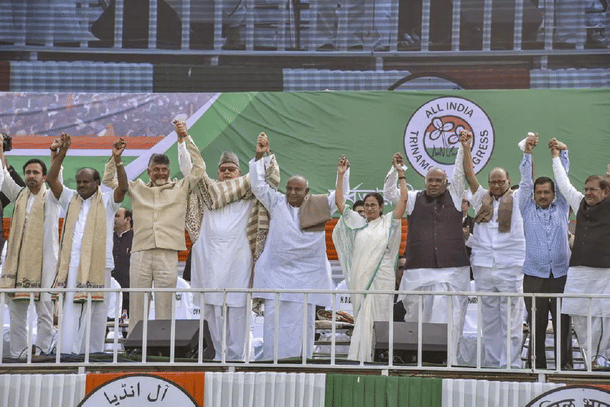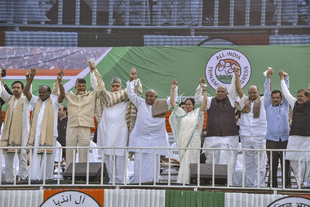Commentary
Here’s What Opposition Leaders Who Will Huddle In Patna Should Realise: Their Seat-Sharing Efforts Will Not Work
Jaideep Mazumdar
Jun 22, 2023, 04:54 PM | Updated 04:54 PM IST
Save & read from anywhere!
Bookmark stories for easy access on any device or the Swarajya app.


On the eve of the opposition conclave in Patna on Friday (23 June), hosts Janata Dal (United) and Rashtriya Janata Dal (RJD) have come up with a seat-sharing formula that they hope will be endorsed by the leaders of the 15-odd parties.
According to this new formula, the performance of each party in the last three elections — parliamentary as well as assembly — will be assessed.
Percentile scores will be accorded to each party based on the number of seats they won, the margins of victory of their successful candidates, the votes polled by their candidates who lost to the BJP (and were the runners-up) and the overall vote share of these parties.
Based on this percentile score, each Lok Sabha constituency will be allotted to the party that has the best prospects in that particular seat. And rival parties will support the ‘joint opposition candidate’ who has been fielded.
The blueprint of this complex formula was shared with leaders of the parties who will attend the one-day conclave.
But this formula suffers from inherent defects. And, more important, the entire seat-sharing formula is based on an entirely flawed concept.
Here Are The Reasons Why The Formula Won’t Work
The political fortunes of many opposition parties have fluctuated, often wildly, over the last three elections spanning the last one decade or less. As such, all parties will insist on going by their best performance in any of the last three elections.
That will trigger bickerings amongst the multiple claimants for most Lok Sabha seats, and there are slim chances of such bickerings spurred by competitive ambitions of the opposition parties from being resolved amicably.
Take the case of Bengal.
The Trinamool Congress won 22 of the 42 Lok Sabha seats in Bengal in the 2019 parliamentary polls and the Congress won two while the CPI(M) drew a blank. The Trinamool’s vote share was 43.69 per cent while the Congress’ was 5.67 per cent and the CPI(M)’s was 6.34 per cent.
In the 2021 assembly elections in Bengal, the Trinamool won 213 of the 294 seats (47.94 per cent vote share) while the Congress and the CPI(M) failed to win any seats and their vote shares were 2.93 per cent and 4.73per cent respectively.
In the 2016 assembly elections, the Trinamool won 211 seats (44.91 per cent vote share), the Congress won 44 seats (12.25 per cent vote share) and the CPI(M) won 26 seats (19.75 per cent vote share).
If the formula devised by the RJD and JD(U) is applied in Bengal, the Congress will be given just one Lok Sabha seat (Baharampur) to contest in the 2024 Lok Sabha polls while the CPI(M) will not get any seats to contest.
But that will be completely unacceptable to both the Congress and the CPI(M). These two parties have already indicated that their performances in the 2014 Lok Sabha polls — the Congress won four seats (9.58 per cent vote share) and CPI(M) won two seats (29.71 per cent vote share) — ought to be taken into account.
State Congress president Adhir Ranjan Chowdhury (who is also his party’s leader in the Lok Sabha) has said his party will not settle for anything less than eight to nine seats. Bengal CPI(M) leaders have told the central party leadership that the party’s prospects are very bright in at least five Lok Sabha seats.
But the Trinamool would like to field candidates in 40 of the 42 seats, and is willing to concede only two seats to the Congress-CPI(M) combine.
Thus, an electoral understanding among the non-BJP parties (Trinamool Congress, CPI(M) and Congress) in Bengal is a pipe dream.
The JD(U)-RJD seat sharing formula — or any seat-sharing formula for that matter — will not work in Uttar Pradesh, Punjab, Delhi, Gujarat, Goa, Karnataka, Andhra Pradesh, Telangana and Kerala which have, amongst them, 218 Lok Sabha seats.
That’s because the non-BJP parties compete with each other and are fierce rivals in these states. Thus, in more than 40 per cent of the total Lok Sabha seats, chances of the opposition (non-BJP) parties fielding ‘joint’ or ‘consensus’ candidates is pretty dim.
The Congress is strong in Himachal Pradesh, Uttarakhand, Rajasthan, Haryana, Chhattisgarh and Madhya Pradesh, and will refuse to concede any seats in these states to any other opposition party. These six states have, among them, 84 Lok Sabha seats.
The Congress leadership is clear that it wants to field candidates in 450 seats, leaving a mere 93 seats to the other opposition parties.
In the eight northeastern states which have 25 Lok Sabha seats, the seat-sharing formula will not work. In fact, no regional party from the North East which is not an ally of the BJP will be attending the conclave at Patna on Friday (23 June ).
The only states where the seat-sharing will work are Bihar, Jharkhand, Tamil Nadu and Maharashtra where the opposition parties are, anyway, in a formal alliance. These four states have, between them, a total of 141 Lok Sabha seats.
The states that will see multi-cornered contests are, thus, Bengal, Odisha, Uttar Pradesh, Uttarakhand, Delhi, Himachal Pradesh, Punjab, Haryana, Rajasthan, Gujarat, Karnataka, Andhra Pradesh, Telangana and Kerala. These 14 states account for 315 Lok Sabha seats.
Thus, Bihar Chief Minister Nitish Kumar’s dream of all the non-BJP parties fielding ‘common’ or ‘consensus’ candidates in a maximum number of Lok Sabha seats is unlikely to turn into reality.
Among the many indicators of that listed above, one more is that some prominent non-BJP (and non-NDA) parties will be absent from Friday’s Patna conclave.
The most prominent absentees will be Telangana Chief Minister K Chandrasekhar Rao’s Bharat Rashtra Samithi (BRS), Andhra CM Y S Jaganmohan Reddy’s YSR Congress Party, the Telugu Desam Party (TDP), former PM H D Deve Gowda’s Janata Dal (Secular), Odisha’s ruling Biju Janata Dal (BJD), Mayawati’s Bahujan Samaj Party (BSP) and many other minor parties.
In Electoral Politics, Two Plus Two Does Not Add Up To Four
The opposition’s simplistic calculation is that if anti-BJP votes do not get divided among various opposition candidates, then the BJP can be easily defeated. But this premise suffers from many flaws.
The primary among them is that fielding a consensus candidate will lead to all or an overwhelming number of anti-BJP votes going to that particular candidate.
The biggest and perhaps most intractable challenge for the (seat-sharing) formula to work is to make the understanding between the different parties work at the grassroots level.
This means getting workers of all the opposition parties to sink their differences and work unitedly for the ‘consensus’ candidate. Experience shows that this is quite impossible to achieve, given the history of fierce animosity between the different parties.
Also, many parties have their loyal voters who, quite often, refuse to vote for a ‘consensus’ candidate belonging to a party they dislike.
For example, even in case a seat-sharing arrangement between the Trinamool Congress, CPI(M) and the Congress is struck, CPI(M) workers are unlikely to work wholeheartedly to ensure the victory of a Trinamool ‘consensus’ candidate in their area, and vice versa. And CPI(M) voters will prefer to keep away from the polling booths rather than vote for a Trinamool candidate.
Thus, transfer of votes from one party to another — especially if the parties have been fierce rivals — even if a seat-sharing arrangement is achieved is highly unlikely.
The Biggest Error In The Opposition’s Calculation
The core premise in the opposition strategy is to prevent fragmentation of the anti-BJP vote.
But the opposition has overlooked the fact that in the 2019 parliamentary polls, the BJP polled more than 50 per cent votes in 224 of the 303 Lok Sabha seats that it won.
In another 38 seats, the BJP’s vote share was above 45 per cent. But the remaining votes were shared not only by major parties, but also by smaller parties and independents who will not be a party to the opposition seat-sharing.
Thus, in more than 48 per cent of the constituencies, the BJP would have won even if major opposition parties had put up ‘consensus’ candidates.
The combined opposition camp does not include a huge number of smaller parties which, between them, garnered a vote share of nearly 18 per cent. While some of these parties have become allies of the BJP, the others have refused to be part of the anti-BJP front.
The major opposition parties which are aiming to unseat the BJP from power next year seem to have overlooked the 18 per cent vote share (nationally) that will not go to their kitty.
Of the 303 Lok Sabha seats won by the BJP in 2019, 106 are from states where the saffron party is in direct contest with the Congress. These states are Himachal Pradesh, Uttarakhand, Rajasthan, Haryana, Gujarat, Madhya Pradesh and Chhattisgarh,
The combined vote share of the other parties (apart from the BJP and Congress) in these states was below 5 per cent, which means they do not matter in these seven states with 110 Lok Sabha seats.
Thus, a seat-sharing agreement among the opposition parties will not make any difference in these seven states.
In the seats where the opposition parties will be able to put up ‘consensus’ candidates, the sole pivot of their campaign is anti-BJPism.
Past experience has shown that unprincipled alliances between opposition parties who are united only in their opposition to one major party — this happened with many small parties teaming up against the Congress in the past — get roundly rejected by voters.
Friday’s opposition conclave will, thus, ultimately turn out to be another opposition exercise in futility.
Post-script: The hosts of Friday’s opposition conclave at Patna have even got their timing wrong. They chose a day when media attention will be focused almost exclusively on Prime Minister Narendra Modi’s ongoing visit to the US. Timing is crucial in politics, and the first step in forging opposition unity (in Patna Friday) will be completely overshadowed by the Prime Minister’s US visit.
Also read: Patna Opposition Unity Meet — The Math Of It
Nitish Kumar’s Opposition Unity Formula Has A Little Problem—Practicality
Explained: Why Nitish Kumar Is So Desperate To Forge Opposition Unity





